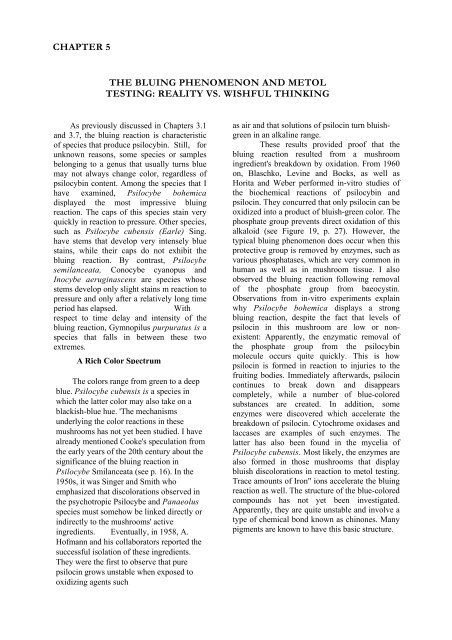Jochen Gartz - Magic Mushrooms Around the ... - preterhuman.net
Jochen Gartz - Magic Mushrooms Around the ... - preterhuman.net
Jochen Gartz - Magic Mushrooms Around the ... - preterhuman.net
You also want an ePaper? Increase the reach of your titles
YUMPU automatically turns print PDFs into web optimized ePapers that Google loves.
CHAPTER 5<br />
THE BLUING PHENOMENON AND METOL<br />
TESTING: REALITY VS. WISHFUL THINKING<br />
As previously discussed in Chapters 3.1<br />
and 3.7, <strong>the</strong> bluing reaction is characteristic<br />
of species that produce psilocybin. Still, for<br />
unknown reasons, some species or samples<br />
belonging to a genus that usually turns blue<br />
may not always change color, regardless of<br />
psilocybin content. Among <strong>the</strong> species that I<br />
have examined, Psilocybe bohemica<br />
displayed <strong>the</strong> most impressive bluing<br />
reaction. The caps of this species stain very<br />
quickly in reaction to pressure. O<strong>the</strong>r species,<br />
such as Psilocybe cubensis (Earle) Sing.<br />
have stems that develop very intensely blue<br />
stains, while <strong>the</strong>ir caps do not exhibit <strong>the</strong><br />
bluing reaction. By contrast, Psilocybe<br />
semilanceata, Conocybe cyanopus and<br />
Inocybe aeruginascens are species whose<br />
stems develop only slight stains m reaction to<br />
pressure and only after a relatively long time<br />
period has elapsed.<br />
With<br />
respect to time delay and intensity of <strong>the</strong><br />
bluing reaction, Gymnopilus purpuratus is a<br />
species that falls in between <strong>the</strong>se two<br />
extremes.<br />
A Rich Color Spectrum<br />
The colors range from green to a deep<br />
blue. Psilocybe cubensis is a species in<br />
which <strong>the</strong> latter color may also take on a<br />
blackish-blue hue. 'The mechanisms<br />
underlying <strong>the</strong> color reactions in <strong>the</strong>se<br />
mushrooms has not yet been studied. I have<br />
already mentioned Cooke's speculation from<br />
<strong>the</strong> early years of <strong>the</strong> 20th century about <strong>the</strong><br />
significance of <strong>the</strong> bluing reaction in<br />
Psilocybe Smilanceata (see p. 16). In <strong>the</strong><br />
1950s, it was Singer and Smith who<br />
emphasized that discolorations observed in<br />
<strong>the</strong> psychotropic Psilocybe and Panaeolus<br />
species must somehow be linked directly or<br />
indirectly to <strong>the</strong> mushrooms' active<br />
ingredients. Eventually, in 1958, A.<br />
Hofmann and his collaborators reported <strong>the</strong><br />
successful isolation of <strong>the</strong>se ingredients.<br />
They were <strong>the</strong> first to observe that pure<br />
psilocin grows unstable when exposed to<br />
oxidizing agents such<br />
as air and that solutions of psilocin turn bluishgreen<br />
in an alkaline range.<br />
These results provided proof that <strong>the</strong><br />
bluing reaction resulted from a mushroom<br />
ingredient's breakdown by oxidation. From 1960<br />
on, Blaschko, Levine and Bocks, as well as<br />
Horita and Weber performed in-vitro studies of<br />
<strong>the</strong> biochemical reactions of psilocybin and<br />
psilocin. They concurred that only psilocin can be<br />
oxidized into a product of bluish-green color. The<br />
phosphate group prevents direct oxidation of this<br />
alkaloid (see Figure 19, p. 27). However, <strong>the</strong><br />
typical bluing phenomenon does occur when this<br />
protective group is removed by enzymes, such as<br />
various phosphatases, which are very common in<br />
human as well as in mushroom tissue. I also<br />
observed <strong>the</strong> bluing reaction following removal<br />
of <strong>the</strong> phosphate group from baeocystin.<br />
Observations from in-vitro experiments explain<br />
why Psilocybe bohemica displays a strong<br />
bluing reaction, despite <strong>the</strong> fact that levels of<br />
psilocin in this mushroom are low or nonexistent:<br />
Apparently, <strong>the</strong> enzymatic removal of<br />
<strong>the</strong> phosphate group from <strong>the</strong> psilocybin<br />
molecule occurs quite quickly. This is how<br />
psilocin is formed in reaction to injuries to <strong>the</strong><br />
fruiting bodies. Immediately afterwards, psilocin<br />
continues to break down and disappears<br />
completely, while a number of blue-colored<br />
substances are created. In addition, some<br />
enzymes were discovered which accelerate <strong>the</strong><br />
breakdown of psilocin. Cytochrome oxidases and<br />
laccases are examples of such enzymes. The<br />
latter has also been found in <strong>the</strong> mycelia of<br />
Psilocybe cubensis. Most likely, <strong>the</strong> enzymes are<br />
also formed in those mushrooms that display<br />
bluish discolorations in reaction to metol testing.<br />
Trace amounts of Iron" ions accelerate <strong>the</strong> bluing<br />
reaction as well. The structure of <strong>the</strong> blue-colored<br />
compounds has not yet been investigated.<br />
Apparently, <strong>the</strong>y are quite unstable and involve a<br />
type of chemical bond known as chinones. Many<br />
pigments are known to have this basic structure.








![The Big Lie 9-11 and Government Complicity in Mass Murder [PDF]](https://img.yumpu.com/50957077/1/190x245/the-big-lie-9-11-and-government-complicity-in-mass-murder-pdf.jpg?quality=85)








